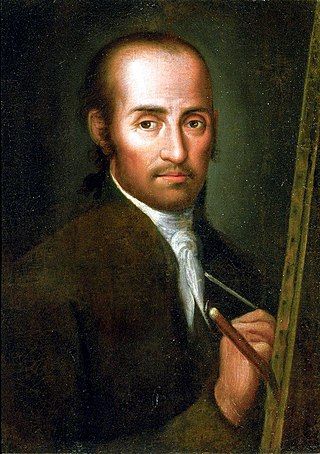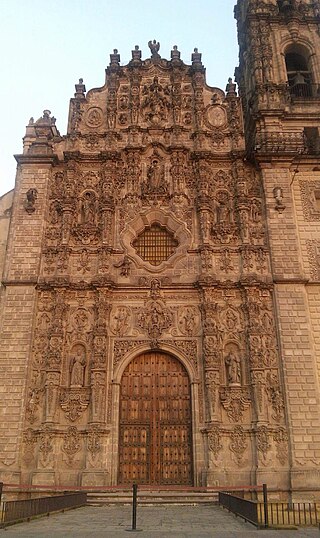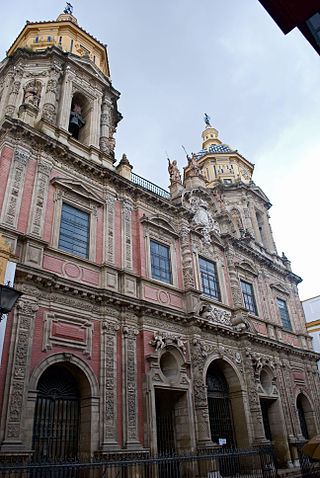
Baroque architecture is a highly decorative and theatrical style which appeared in Italy in the early 17th century and gradually spread across Europe. It was originally introduced by the Catholic Church, particularly by the Jesuits, as a means to combat the Reformation and the Protestant church with a new architecture that inspired surprise and awe. It reached its peak in the High Baroque (1625–1675), when it was used in churches and palaces in Italy, Spain, Portugal, France, Bavaria and Austria. In the Late Baroque period (1675–1750), it reached as far as Russia, the Ottoman Empire and the Spanish and Portuguese colonies in Latin America. In about 1730, an even more elaborately decorative variant called Rococo appeared and flourished in Central Europe.

The Church of the Gesù is the mother church of the Society of Jesus (Jesuits), a Catholic religious order. Officially named Chiesa del Santissimo Nome di Gesù, its façade is "the first truly baroque façade", introducing the baroque style into architecture. The church served as a model for innumerable Jesuit churches all over the world, especially in the central Europe and then in the Portuguese colonies. Its paintings in the nave, crossing, and side chapels became models for Jesuit churches throughout Italy and Europe, as well as those of other orders. The Church of the Gesù is located in the Piazza del Gesù in Rome.

Francis Borgia was a Spanish Jesuit priest. The great-grandson of both Pope Alexander VI and King Ferdinand II of Aragon, he was Duke of Gandía and a grandee of Spain. After the death of his wife, Borgia renounced his titles and became a priest in the Society of Jesus, later serving as its third superior general. He was canonized on 20 June 1670 by Pope Clement X.

Diego Laynez, S.J., born in 1512 and died on 19 January 1565 (Rome), was a Spanish Jesuit priest and theologian, a New Christian, and the second Superior General of the Society of Jesus after the founder Ignatius of Loyola.

The Basilica Cathedral of Puebla, as the Cathedral of Our Lady of the Immaculate Conception is known according to its Marian invocation, is the episcopal see of the Archdiocese of Puebla de los Ángeles (Mexico). It is one of the most important buildings in the historic center of Puebla declared a World Heritage Site by UNESCO. It has the prerogative of being the first sumptuous temple that under fine architectural designs was built in the Americas, consecrated in 1649, ahead of the Metropolitan of Mexico that was dedicated in 1653. It was founded by Philip II of Spain.

José de Ibarra (1688–1756) was a New Spanish painter. He was born in Guadalajara, Mexico in 1688, and died November 21, 1756, in Mexico City, in the Viceroyalty of New Spain. Ibarra was a disciple of the distinguished painter Juan Correa (1646-1716), whose parents were of Afro-Moorish Afro-Mexican descent. José de Ibarra is, along with Juan Rodríguez Juárez (1675-1728), one of the most prominent figures in painting from the first half of the 18th century in New Spain, modern day's Mexico. A follower of the artistic renewal promoted by the brothers Juan and Nicolás Rodríguez Juárez, in whose workshop he collaborated, Ibarra cultivated in his work the language of pictorial modernism with strong Italian and French influences. This would be the direct antecedent of the work of Miguel Cabrera (1715-1768), whose fame would eclipse that of which Ibarra himself enjoyed among his contemporaries as a brush artist.

Cristóbal de Villalpando was a Baroque Criollo artist from New Spain, arts administrator and captain of the guard. He painted prolifically and produced many Baroque works now displayed in several Mexican cathedrals, including the cathedrals in Querétaro and Mexico City, as well as a depiction of the Zócalo in Mexico City, showing the damage of the 1692 riot to the viceregal palace three years earlier.

Juan Correa (1646–1716) was a distinguished Mexican painter of the late seventeenth and early eighteenth centuries. His years of greatest activity were from 1671 to 1716. He was the Afro-Mexican son of a mulatto physician from Cádiz, Spain, and a freed black woman, Pascuala de Santoyo. Correa "became one of the most prominent artists in New Spain during his lifetime, along with Cristóbal de Villalpando."Manuel Toussaint considers Correa and Villalpando the main exponents of the Baroque style of painting in Mexico. James Oles writes that "Correa and Villalpando created a distinctive—if at times formulaic—style that hearkened back to the strong Mannerist traditions of the mid-sixteenth century."

The Museo Nacional del Virreinato is located in the former College of San Francisco Javier in Tepotzotlán, Mexico State, Mexico. It belongs to Consejo Nacional para la Cultura y las Artes. The complex was built by the Aztecs, and used by the Jesuits starting in the 1580s. Three centers of learning were founded in the complex: a school to teach indigenous languages to Jesuit evangelists, a school for native boys, and the College of San Francisco Javier, to train Jesuit priests. The complex comprises three sections: the college area, with dormitories, a library, a kitchen, and a domestic chapel; the Church of San Francisco Javier; and the Church of San Pedro Apostol. The former college and the Church of San Francisco Javier have been converted into the Museo del Virreinato, with the former college area housing a large collection of art and ordinary objects from the colonial era, and the Church of San Francisco Javier housing one of the most important collections of Churrigueresque altarpieces in Mexico. The Church of San Pedro Apostol is the only part of the entire complex that is still used for religious purposes.

The Sanctuary of Atotonilco is a church complex and part of a World Heritage Site, designated along with nearby San Miguel de Allende, Guanajuato, Mexico. The complex was built in the 18th century by Father Luis Felipe Neri de Alfaro, who, according to tradition, was called upon by a vision of Jesus with a crown of thorns on his head with blood on his face and carrying a cross. The main feature of the complex is the rich Mexican Baroque mural work that adorns the main nave and chapels. This was chiefly the work of Antonio Martínez de Pocasangre over a period of thirty years. The mural work has led the complex to be dubbed the "Sistine Chapel of Mexico." The complex remains a place of worship and penance to this day, attracting as many as 5,000 visitors every week.

New Spanish Baroque, also known as Mexican Baroque, refers to Baroque art in the Viceroyalty of New Spain. During this period, artists of New Spain experimented with expressive, contrasting, and realistic creative approaches, making art that became highly popular in New Spanish society.

The Iglesia de la Compañía de Jesús is a historic Jesuit church in Cusco, the ancient capital of the Inca Empire, in Cusco Region, Peru. It is situated in the Plaza de Armas de Cusco, the city center. It is built on an Inca palace. It is one of the best examples of Spanish Baroque architecture in Peru. The architecture of this building exerted a great influence on the development of many Baroque architecture in the South Andes. Its construction began in 1576, but it was badly damaged in an earthquake in 1650. The rebuilt church was completed in 1673.

The Church and Convent of San Ignacio de Loyola de la Compañía de Jesús de Quito, also known in the Ecuadorian people simply as La Compañía, is a Catholic clerical complex located on the corner formed by calles García Moreno and Sucre, in the Historic Center of the city of Quito, capital of Ecuador. The façade of its main temple is entirely carved in volcanic stone. Over time, this church has also been called: "Temple of Solomon of South America". Father Bernardo Recio, a traveling Jesuit, called it "Golden Ember".
The Cave of Saint Ignatius is a sanctuary declared as a Local Cultural Heritage that includes a baroque church and a neoclassical building in Manresa (Catalonia), which was created to honor the place where, according to tradition, Saint Ignatius of Loyola shut himself in a cave to pray and do penance during his sojourn in the city from March 1522 to February 1523, where he wrote the Spiritual Exercises returning from his pilgrimage to Montserrat.

The San Pedro Apostol Parish Church, commonly known as Loboc Church and alternatively as the Diocesan Shrine of Our Lady of Guadalupe in Extremadura, is a Roman Catholic church in the municipality of Loboc, Bohol, Philippines, within the jurisdiction of the Roman Catholic Diocese of Tagbilaran.

San Ignacio Church in Intramuros, Manila, Philippines, was designed for the Jesuits by architect Félix Roxas Sr., and completed in 1899. It was known as their "Golden Dream" but was destroyed during World War II. Its interiors, embellished with carvings, had been designed by Isabelo Tampinco.

La Dolorosa is a work by Cristóbal de Villalpando probably painted between 1680 and 1689 and belonging to the collection of the Museo Soumaya in Mexico City.

The Church of Saint Louis of France, located in the historic district of Seville, Spain, represents an example of Baroque architecture in the 18th century. The church was designed by the architect Leonardo of Figueroa and constructed between 1699 and 1731 on behalf of the Jesuits. Following the expulsion of the Jesuits from Spain in 1835, it had different uses and was eventually deconsecrated. The building currently belongs to the Provincial Council of Seville.

























